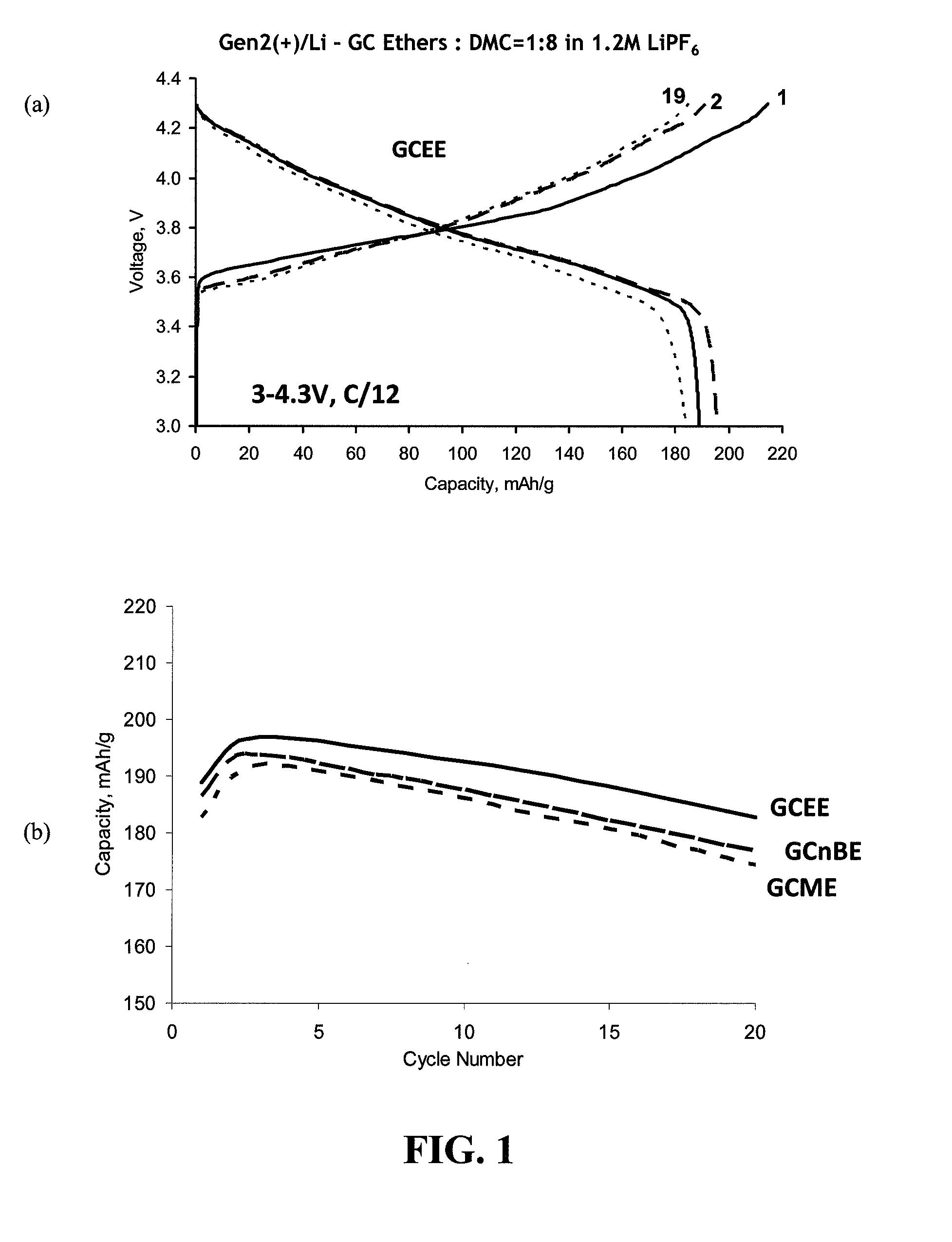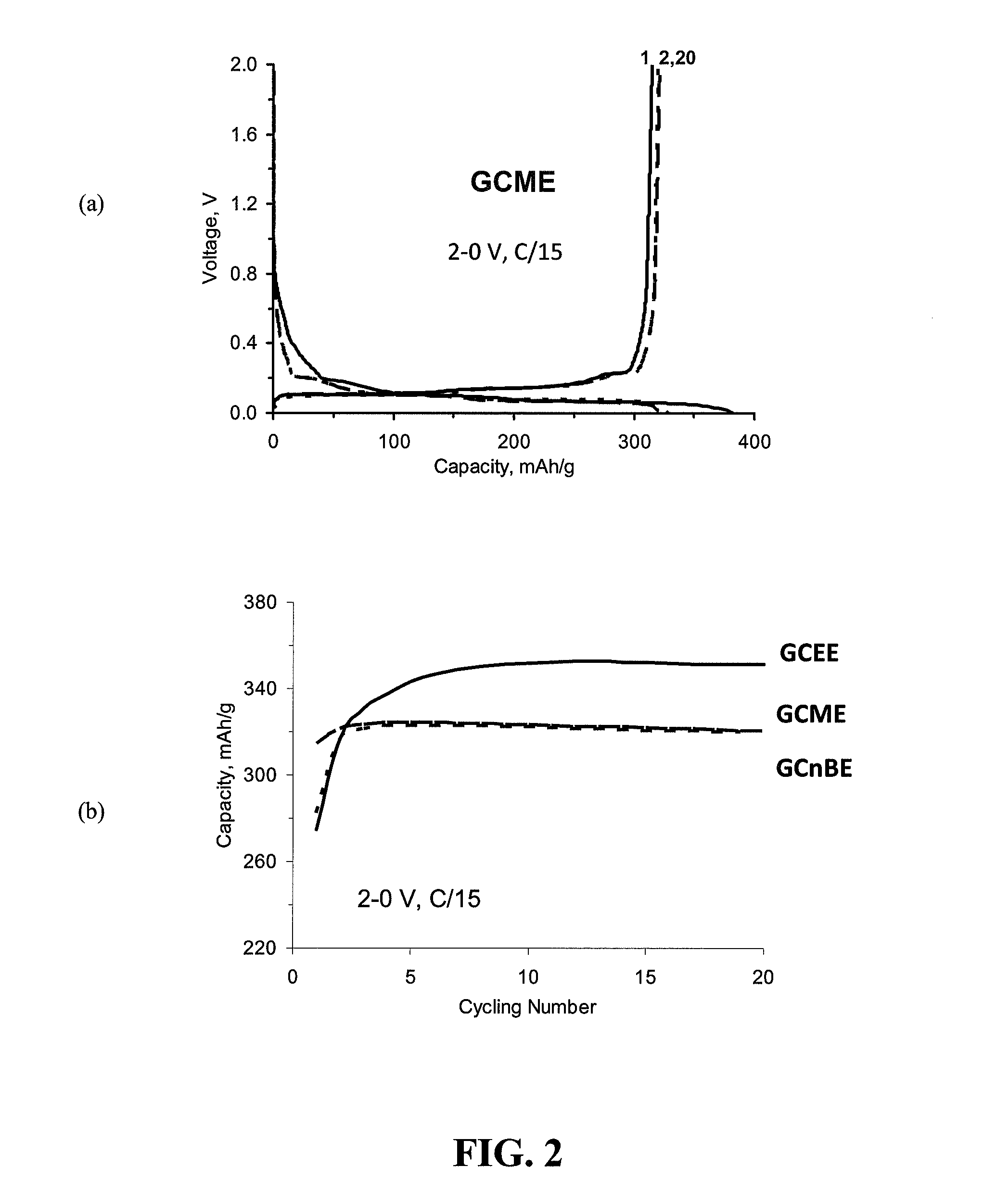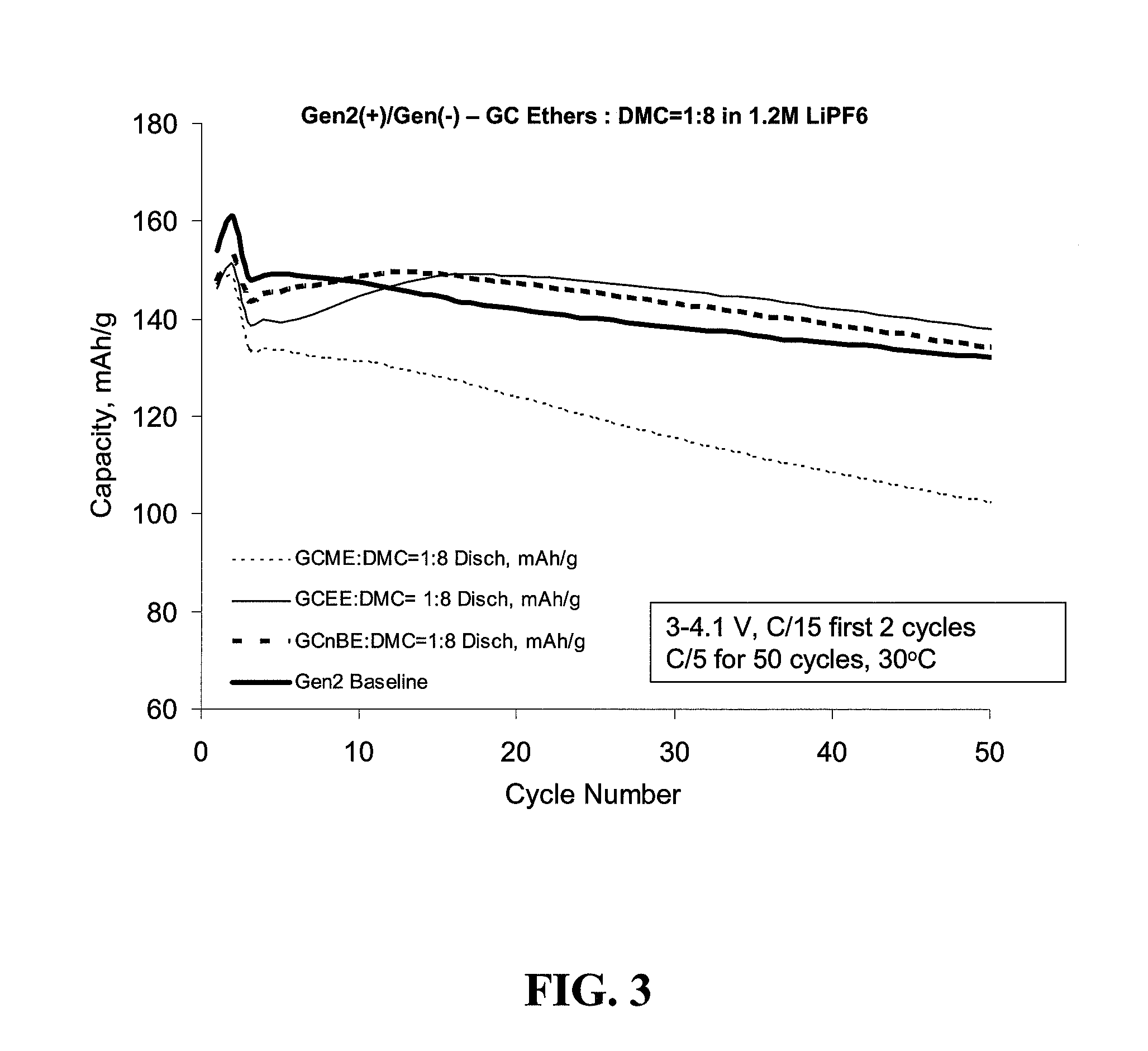Electrolyte compositions for lithium and lithium-ion batteries
a lithium-ion battery and electrolyte technology, applied in the direction of non-aqueous electrolyte cells, cell components, electrochemical generators, etc., can solve the problems of limited widespread commercialization of lithium batteries for transportation applications, and achieve the effects of less flammability, superior safety characteristics, and low vapor pressur
- Summary
- Abstract
- Description
- Claims
- Application Information
AI Technical Summary
Benefits of technology
Problems solved by technology
Method used
Image
Examples
example 1
[0055]Electrolyte compositions comprising 1.2 M LiPF6 in a 1:8 (w / w) mixture of GC ether derivative of Formula (I) and DMC were prepared. In the GC ether derivatives used, X═O, and R=ethyl (GCEE), butyl (GCnBE), methyl (GCME). The electrolytes were evaluated in lithium half cells with the Gen2 cathode or with the Gen2 anode, and in full cells containing the Gen2 cathode and the Gen2 anode.
[0056]FIG. 1, Panel (a) provides a graph of voltage (V) versus capacity (mAh / g) for cycles 1, 2, and 19 over a range of about 3 to 4.3 V at C / 12 charging rate obtained with the GCEE in a lithium half cell with Gen2 cathode. FIG. 1, Panel (b) provides a graph of capacity versus cycle number obtained with the three GC derivatives (GCEE, GCME and GCnBE). The data in FIG. 1 show that there was a good first cycle coulombic efficiency (about 88%) and reversible capacity for GCEE, comparable to that of the Gen2 electrolyte (about 180 mAh / g).
[0057]FIG. 2, Panel (a) provides a graph of voltage versus capaci...
example 2
[0059]Electrolyte compositions comprising 1.2 M LiPF6 in pure GC ether derivatives of Formula (I) were prepared. In the GC derivatives used X═O, and R=ethyl (GCEE), methyl (GCME), isopropyl (GCiPE), n-butyl (GCnBE), isobutyl (GCiBE), and tert-butyl (GCiBE). The electrolytes were evaluated in lithium half cells with the Gen2 cathode or with the Gen2 anode.
[0060]FIG. 4, Panel (a) provides a graph of voltage versus capacity for cycles 1, 2, and 20 obtained with the GCEE in a lithium half cell with Gen2 anode (2 to 0 V cycle range, C / 12 charging rate). FIG. 4, Panel (b) provides a graph of capacity versus cycle number obtained with GCEE and GCME. The data in FIG. 4 show that the cell can be cycled with a graphite anode at about 300 mAh / g capacity, but the first cycle coulombic efficiency is relatively low.
[0061]FIG. 5 provides a graph of voltage versus capacity for cycles 1, 2, and 20 obtained with the GCME in a lithium half cell with Gen2 cathode (3 to 4.3 V cycle range, C / 12 charging ...
example 3
[0064]Electrolyte compositions comprising 0.3 M LiB(C2O4)2 in pure GC ether derivatives of Formula (I) were prepared. In the GC derivatives used X═O, and R=ethyl (GCEE), methyl (GCME), isopropyl (GCiPE), n-butyl (GCnBE), isobutyl (GCiBE), and tert-butyl (GCiBE). The electrolytes were evaluated in lithium half cells with the Gen2 cathode or with the Gen2 anode, and in full cells containing the Gen2 cathode and the Gen2 anode.
[0065]FIG. 8, Panel (a) provides a graph of charge capacity versus cycle number for up to 20 cycles obtained with the GCME, GCEE, and GCnBE in lithium half cells with Gen2 cathode (3 to 4.3 V cycle range, C / 20 charging rate). FIG. 8, Panel (b) provides a graph of discharge capacity versus cycle number for up to 20 cycles obtained with the GCME, GCEE, and GCnBE in lithium half cells with Gen2 cathode (3 to 4.3 V cycle range, C / 20 charging rate). The GCME cell died after 14 cycles.
[0066]FIG. 9 provides a graph of discharge capacity versus cycle number for up to 20 ...
PUM
| Property | Measurement | Unit |
|---|---|---|
| temperature | aaaaa | aaaaa |
| voltage | aaaaa | aaaaa |
| voltage | aaaaa | aaaaa |
Abstract
Description
Claims
Application Information
 Login to View More
Login to View More - R&D
- Intellectual Property
- Life Sciences
- Materials
- Tech Scout
- Unparalleled Data Quality
- Higher Quality Content
- 60% Fewer Hallucinations
Browse by: Latest US Patents, China's latest patents, Technical Efficacy Thesaurus, Application Domain, Technology Topic, Popular Technical Reports.
© 2025 PatSnap. All rights reserved.Legal|Privacy policy|Modern Slavery Act Transparency Statement|Sitemap|About US| Contact US: help@patsnap.com



